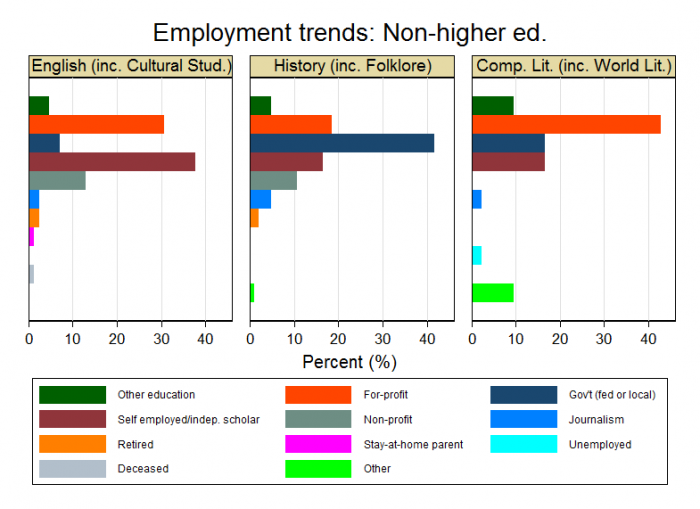We’ve established that the majority of grads from most departments in our sample work in higher education. However, we also noted that many humanities PhDs (about a quarter of the grads for whom occupational information is available) work in other sectors post-completion. It seems intuitive that these employment patterns would vary by discipline.
In this post, we focus on our most densely populated disciplines – English (including Cultural Studies), History (including Folklore), and Comparative Literature (including World Literature). Restricting our analysis to grads working outside of higher education, we find that government employment (local and federal) is especially high among History grads, and self-employment/independent scholar trends are most pronounced among English grads. Employment in the for-profit sector is particularly high among Comparative Literature grads, with many grads working as consultants, analysts, and writers/editors.

Although we can’t say much about our more sparsely populated departments, our data suggests that employment distributions among Classics and Philosophy grads are fairly similar to the Comparative Literature distribution illustrated above. Employment in the non-profit sector is most particularly common among Law, Communication, and Art History grads in our sample.
Our cross-sectional dataset does not allow us to conclude that certain disciplines better prepare grads for careers in specific sectors, but these associations are certainly interesting and merit further investigation. Next time, we’ll begin to explore geographic trends – check back soon!
We’ve established that the majority of grads from most departments in our sample work in higher education. However, we also noted that many humanities PhDs (about a quarter of the grads for whom occupational information is available) work in other sectors post-completion. It seems intuitive that these employment patterns would vary by discipline.
In this post, we focus on our most densely populated disciplines – English (including Cultural Studies), History (including Folklore), and Comparative Literature (including World Literature). Restricting our analysis to grads working outside of higher education, we find that government employment (local and federal) is especially high among History grads, and self-employment/independent scholar trends are most pronounced among English grads. Employment in the for-profit sector is particularly high among Comparative Literature grads, with many grads working as consultants, analysts, and writers/editors.

Although we can’t say much about our more sparsely populated departments, our data suggests that employment distributions among Classics and Philosophy grads are fairly similar to the Comparative Literature distribution illustrated above. Employment in the non-profit sector is most particularly common among Law, Communication, and Art History grads in our sample.
Our cross-sectional dataset does not allow us to conclude that certain disciplines better prepare grads for careers in specific sectors, but these associations are certainly interesting and merit further investigation. Next time, we’ll begin to explore geographic trends – check back soon!
Discussion
I posted this to Twitter and got some questions about the data, mostly related to how time is treated in the data collection? For example, if self-employment/independent scholar trends are most pronounced among English, that is just at the moment that the data is collected, but we don’t know ~how long~ that has been their position (so to speak)? Will there be any way to cast more light on this data, either using more data from Stage 1 or from Stage 2?
I agree – it would be very interesting to track length of employment in a given position/job type. Our dataset is currently cross-sectional, meaning that we have only one observation timepoint per grad. Given the data collection method, which relies on publicly-available information, it would be tricky (or potentially impossible) to reliably document length of employment and/or career changes – this info would need to be consistently available for all grads in our sample.
We do have data on graduation year, which could provide some insight into the relationship between occupation and length of time post-completion. For example, we might expect higher faculty employment among grads who completed their degrees in 2005 vs. 2010, simply due to greater time spent on the job market. We still won’t be able to establish length of employment for a given grad (without asking them directly), but we could certainly take a closer look at the association between length of time in the workforce and occupation type. I’ll check this out and post something soon. Thanks for the feedback!